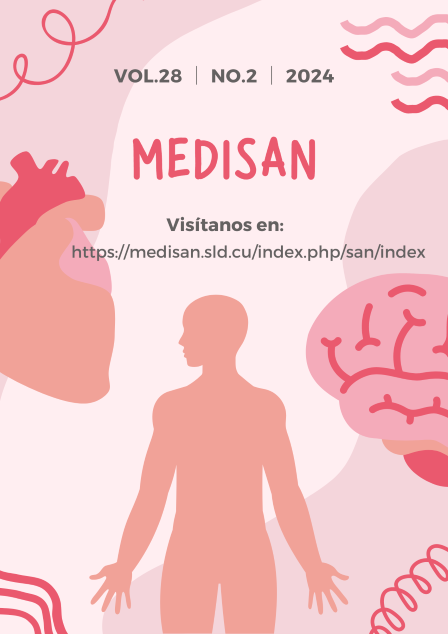Lipotransference by assisted decantation with stem cells of adipose tissue for the facial rejuvenation
Keywords:
stem cells, adipose tissue, lipotransference, facial rejuvenationAbstract
Introduction: The myth to rejuvenate or to be eternally beautiful is a dream that the humanity has always shared in many legends.
Objective: To evaluate the results of lipotransference by assisted decantation with stem cells of adipose tissue for the facial rejuvenation.
Methods: A descriptive, prospective and longitudinal study was carried out with 35 patients selected by simple random sampling in the Plastic Surgery Service of Hermanos Ameijeiras Hospital in Havana city, from September, 2019 to the same month in 2022.
Results: In the case material, the mean age was of 46,5 ± 11,5 years with minimum values of 34 and maximum 57 years; 48.6% was in the 50-59 age group. A prevalence of the II cutaneous phototype was verified (60.0%); in healthy patients, the highest percentage with aging degree was that of type III (57.1%). There was a prevalence of fine wrinkles in rest and deeper lines with facial expression (40.0%) in those who would receive assisted lipotransference. After the treatment improvement was verified in all the patients; none presented complication. The evaluation of this procedure was good (94.3%).
Conclusions: Lipotransference is a minimumly invasive procedure with advantages as for histocompatibility, durability and smaller number of complications; it has a high rate of acceptance. The favorable final result, security and effectiveness are observed in the patient's satisfaction.Downloads
References
2. Ma X, Wu L, Ouyang T, Ge W, Ke J. Safety and Efficacy of Facial Fat Grafting Under Local Anesthesia. Aesthetic Plast Surg. 2018; 42:151-8.
3. Crowley JS, Kream E, Fabi S, Cohen SR. Facial Rejuvenation With Fat Grafting and Fillers. Aesthet Surg J. 2021 [citado 02/04/2023];41(suppl 1):S31-8. Disponible en: https://academic.oup.com/asj/article/41/Supplement_1/S31/6277493
4. Wufuer M, Choi TH, Najmiddinov B, Kim J, Choi J, Kim T, et al. Improving Facial Fat Graft Survival Using Stromal Vascular Fraction-Enriched Lipotransfer: A Prospective Multicenter, Randomized Controlled Study. Plast Reconstr Surg. 2024;153(4):690e-700e.
5. Carruthers A, Carruthers J, Hardas B, Kaur M, Goertelmeyer R, Jones D, et al. A validated grading scale for forehead lines. Dermatol Surg. 2008;34(suppl 2):S155-60.
6. Shrestha B, Dunn L. The Declaration of Helsinki on Medical Research involving Human Subjects: A Review of Seventh Revision. J Nepal Health Res Counc. 2020;17(4):548-52.
7. Zouboulis CC, Ganceviciene R, Liakou AI, Theodoridis A, Elewa R, Makrantonaki E. Aesthetic aspects of skin aging, prevention, and local treatment. Clin Dermatol. 2019 [citado 02/04/2023];37(4):365-72. Disponible en: https://www.sciencedirect.com/science/article/abs/pii/S0738081X19300690?via%3Dihub
8. Molina Linares II, Mora Marcial GR, González Pérez S, Morales Rodríguez CM, Ferrer Calero OL, Broche Manso Y. Características clínico-epidemiológicas de pacientes con lesiones malignas en la piel. Medicentro. 2020 [citado 10/04/2023];24(2). Disponible en: https://medicentro.sld.cu/index.php/medicentro/article/view/3071/2549
9. Özkoca D, Aşkın Ö, Engin B. Treatment of periorbital and perioral wrinkles with fractional Er:YAG laser: What are the effects of age, smoking, and Glogau stage? J Cosmet Dermatol. 2021;20(9):2800-4.
10. La Padula S, Hersant B, Bompy L, Meningaud JP. In search of a universal and objective method to assess facial aging: The new face objective photonumerical assessment scale. J Craniomaxillofac Surg. 2019 [citado 10/04/2023];47(8):1209-15. Disponible en: https://www.sciencedirect.com/science/article/abs/pii/S1010518218311296?via%3Dihub
11. Buranasirin P, Pongpirul K, Meephansan J. Development of a Global Subjective Skin Aging Assessment score from the perspective of dermatologists. BMC Res Notes. 2019 [citado 10/04/2023];12(1):364. Disponible en: https://bmcresnotes.biomedcentral.com/articles/10.1186/s13104-019-4404-z
12. Jdid R, Latreille J, Soppelsa F, Tschachler E, Morizot F. Validation of digital photographic reference scales for evaluating facial aging signs. Skin Res Technol. 2018;24(2):196-202.
13. Bashir A, Bashir MM, Sohail M, Choudhery MS. Adipose Tissue Grafting Improves Contour Deformities Related Hyperpigmentation of Face. J Craniofac Surg. 2020;31(5):1228-31.
14. Vera Ramírez V, Morales Sánchez MA, Santa Cruz FJ, Medina Bojórquez A. Escalas clínicas para evaluar el envejecimiento cutáneo: una revisión de la literatura. Rev Cent Dermatol Pascua. 2021 [citado 20/04/2023];30(2):68-75. Disponible en: https://www.medigraphic.com/cgi-bin/new/resumen.cgi?IDARTICULO=101176
15. Molina Burbano F, Smith JM, Ingargiola MJ, Motakef S, Sanati P, Lu J, et al. Fat Grafting to Improve Results of Facelift: Systematic Review of Safety and Effectiveness of Current Treatment Paradigms. Aesthet Surg J. 2021 [citado 13/04/2023];41(1):1-12. Disponible en: https://academic.oup.com/asj/article/41/1/1/5697352
16. Surowiecka A, Strużyna J. Adipose-Derived Stem Cells for Facial Rejuvenation. J Pers Med. 2022 [citado 23/04/2023];12(1):117. Disponible en: https://www.ncbi.nlm.nih.gov/pmc/articles/PMC8781097/
17. Xie Y, Huang RL, Wang W, Cheng C, Li Q. Fat Grafting for Facial Contouring (Temporal Region and Midface). Clin Plast Surg. 2020 [citado 18/04/2023];47(1):81-9. Disponible en: https://www.sciencedirect.com/science/article/pii/S0094129819300872?via%3Dihub
18. Zhanqiang L. Fat Grafting for Pan-Facial Contouring in Asians: A Goal-Oriented Approach Based on the Facial Fat Compartments. Clin Plast Surg. 2020 [citado 08/04/2023];47(1):111-7. Disponible en: https://www.sciencedirect.com/science/article/abs/pii/S009412981930094X?via%3Dihub
19. Yang F, Ji Z, Peng L, Fu T, Liu K, Dou W, et al. Efficacy, safety and complications of autologous fat grafting to the eyelids and periorbital area: A systematic review and meta-analysis. PLoS One. 2021 [citado 10/04/2023];16(4):e0248505. Disponible en: https://journals.plos.org/plosone/article?id=10.1371/journal.pone.0248505
Published
How to Cite
Issue
Section
License
All the articles can be downloaded or read for free. The journal does not charge any amount of money to the authors for the reception, edition or the publication of the articles, making the whole process completely free. Medisan has no embargo period and it is published under the license of Creative Commons, International Non Commercial Recognition 4.0, which authorizes the copy, reproduction and the total or partial distribution of the articles in any format or platform, with the conditions of citing the source of information and not to be used for profitable purposes.





